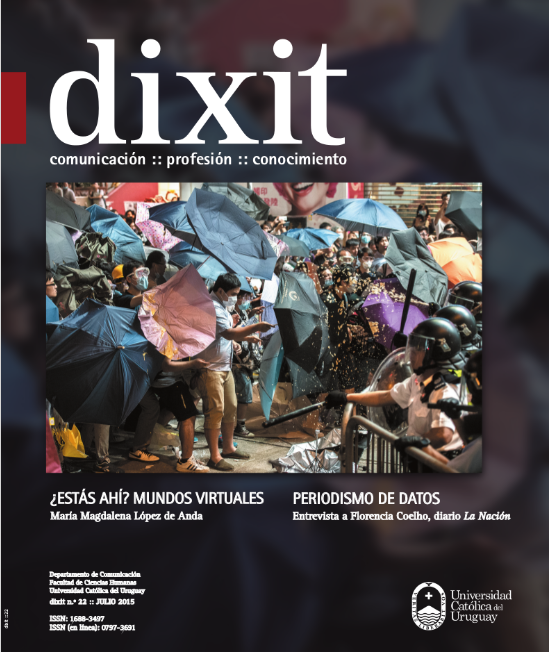¿Estás ahí? Representación y co-presencia en mundos virtuales
DOI:
https://doi.org/10.22235/d.v0i22.378Palabras clave:
comunicación mediada por computadora (CMC), representación, co-presencia, Second Life, mundos virtualesResumen
La interacción social en mundos virtuales se experimenta por medio de prácticas que requieren formas de representación digital de quienes participan en ellas. A partir de una observación sistemática en el entorno virtual Second Life (SL), se pretende contribuir a la comprensión de algunas relaciones entre los recursos a través de los cuales los usuarios se muestran a los demás y favorecen una percepción de co-presencia. Se identifican y caracterizan siete formas de relación entre co-presencia y representación. Estas siete categorías dan cuenta de condiciones técnicas del entorno y de estrategias de los participantes para responder a determinadas dinámicas de interacción, haciendo uso de recursos de manejo temporal (ritmos de participación) y espacial (co-presencia diversificada). En conclusión, las formas de encuentro a la distancia amplían la sensación de ubicuidad de los sujetos y representan competencias clave de nuevas formas de socialidad reticular y multiescénica.
Descargas
Citas
Andersen, P. B., y Nowak, P. (2002). Tangible Objects: Connecting Informational and Physical Space (pp. 190-214). L. Qvortrup (Ed.), Virtual Space: Spatiality in Virtual Inhabited 3D Worlds. Londres: Springer.
Benedikt, M. (2008). Cityspace, Cyberspace, and the Spatiology of Information. Journal of Virtual Worlds Research, 1(1), 1-22.
Benedikt, M. (Ed.) (1991). Cyberspace. Cambridge (EUA): MIT Press.
Bodumn, L., y Kjems, E. (2002). Mapping Virtual Worlds. L. Qvortrup (Ed.), Virtual Space: Spatiality in Virtual Inhabited 3D Worlds (pp. 75-92). Londres: Springer.
Boellstorff, T. (2008). Coming of Age in Second Life: An Anthropologist Explores the Virtually Human. Princeton: Princeton University Press.
Castells, M., Ardévol, M., Linchuan, J., y Araba, S. (2007). Future assemblies: theorizing mobilities and users. New Media and Society, 9(6), 1029-1036.
Castronova, E. (2003). Theory of the avatar. CESIFO Working Papers. Recuperado de: http://www.cesifogroup.de/pls/guestci/download/CESifo%20Working%20Papers%202003/CESifo%20Working%20Papers%20February%202003%20/cesifo_wp863.pdf
Castronova, E. (2005). Synthetic Worlds: The Business and Culture of Online Games. Chicago: University of Chicago Press.
Cortazar, F. J. (1998). Ciberrelaciones: amistad, amor y sexo en los salones de chat. Comunicación y Sociedad, 34, 129-155.
Crary, J. (1990). Techniques of the Observer: On Vision and Modernity in the Nineteenth Century. Cambrigde (EUA): MIT Press.
Czarnecki, K. (2008). Building Community as a Library in a 3D Environment. Australasian Public Libraries and Information Services (APLIS), 21(1), 25-27. Recuperado de: http://web.ebscohost.com/ehost/pdf?vid=8&hid=12&sid=b793179d-6ec2-4a27-a28c-9726195f6c9e40sessionmgr2
Eco, U. (1978). La estructura ausente: introducción a la semiótica. Barcelona: Lumen.
Fornäs, J., Kajsa, K., Martina, L., y Jenny, S. (2002). In Digital Borderlands: Cultural Studies of Identityand Interactivity on the Internet. Nueva York: Peter Lang.
Fortunati, L. (2005). Is Body-to-body Communication still the Prototype? The Information Society, 21, 53-61. Doi: 10.1080/01972240590895919
Gálvez, A. (2004). Análisis de la producción de sociabilidad en entornos virtuales. Athenea Digital, 05(02). Recuperado de: http://site.ebrary.com/lib/uisantafesp/Top?channelName=uisantafesp&cpage=1&docID=10122146&f00=text&frm=smp.x&hitsPerPage=20&layout=document&p00=comunidad+virtual&sch=%A0%A0%A0%A0%A0Buscar%A0%A0%A0%A0%A0&sortBy=score&sortOrder=desc&ppg=7
Giddens, A. (1984). The Constitution of Society. Berkeley: University of California Press.
Goffman, E. (1963). Behavior in Public Places. Nueva York: The Free Press.
Headrick, R. (2000). When information came of age: Technologies of knowledge in the Age of Reason and Revolution (1700-1850). Nueva York: Oxford University Press.
Jakobson, R. (1960). Closing Statement: Linguistics and Poetics (pp. 350-377). T. Sebeok (Ed.), Style in Language. Cambridge (EUA): MIT Press.
Kampmann, B. (2002). The Ontology of Virtual Space: In search of Matrixes and Cube-machines (pp. 285-306). L. Qvortrup (Ed.), Virtual Space: Spatiality in Virtual Inhabited 3D Worlds. Londres: Springer.
Klastrup, L. (2002). Interaction Forms, Agents and Tellable Events in EverQuest Paper presented at the Proceedings of Computer Games and Digital Cultures Conference]. Tampere.
Lankoski, P., y Björk, S. (2007). Gameplay Design Patterns for Believable Non-layer Characters. [Paper presented at the DIGRA Conference].
Lengel, L. (2009). Computer-Mediated Communication 21st Century Communication: A Reference Handbook. Recuperado de: http://www.sage-ereference.com/communication/Article_n60.html
López, M. (2007). Estética y representación espacial en Ragnarok On Line. México: Universidad La Salle.
Murray, J. (1997). Hamlet en la holocubierta. El futuro de la narrativa en el ciberespacio. Barcelona: Paidós.
Nielsen, R. (2002). Collaborative Spaces: inhabited Virtual Worlds (pp. 171-210). L. Qvortrup (Ed.), Virtual Space: Spatiality in Virtual Inhabited 3D Worlds. Londres: Springer.
Nowak, K, y Rauh, C. (2002). The Influence of the Avatar on Online Perceptions of Anthropomorphism, Androgyny, Credibility, Homophily, and Attraction. Journal of Computer-Mediated Communication, 11, 153-178.
Pearce, C. (2009a). Collaboration, Creativity and Learning in a Play Community: A Study of the University of There [Paper presented at the DIGRA Conference, Uxbridge University]. Londres.
Pearce, C. (2009b). Communities of play. Emergent cultures in multiplayer games and virtual worlds. Cambridge (EUA): MIT Press.
Peirce, Ch. (1931-1966). Collected Papers of Charles Sanders Peirce (C. Hartshorne, P. Weiss y W. Burks Eds.). Cambridge (EUA): Harvard University Press.
Peirce, Ch. (1986). La ciencia de la semiótica (A. Sercovich Ed.). Buenos Aires: Nueva Visión.
Qvortrup, L. (2002). Cyberspace as Representation of Space Experience: In defence of a Phenomenological Approach (pp. 5-24). L. Qvortrup (Ed.), Virtual Space: Spatiality in Virtual Inhabited 3D Worlds. Londres: Springer.
Ravetz, J. (1998). The Internet, virtual and real reality (pp. 113- 122). B. Loader (Ed.), Ciberspace Divide: Equality, Agency and Policy in the Information Society. Londres: Routledge.
Scolari, C. (2008). Hipermediaciones, elementos para una Teoría de la Comunicación Digital Interactiva. Barcelona: Gedisa.
Sterling, B. (1994). The Virtual City [Paper presented at the Rice Design Alliance]. Houston, Texas.
Taekke, J. (2002). Cyberspace as a Space Parallel to Geographical Space (pp. 25-43). L. Qvortrup (Ed.), Virtual Space: Spatiality in Virtual Inhabited 3D Worlds. Londres: Springer.
Taylor, T. L. (2002). Living Digitally: Embodiment in Virtual Worlds (pp.40-62). R. Schroeder (Ed.), The Social Life of Avatars: Presence and Interaction in Shares Virtual Enviroments. Londres: Springer.
Thalmann, D. (s/f). Challenges for the Research in Virtual Humans. Recuperado de: http://citeseerx.ist.psu.edu/ vie-doc/download?doi=10.1.1.24.1493&rep=rep1&type=pdf
Todorov, T. (2007). La Conquista de América. El problema del otro. México: Siglo XXI.
Trabajadores de IBM inician mañana la primera huelga en “Second Life” por recorte salarial (2007). El País. Madrid. Recuperado de: http://tecnologia.elpais.com/tecnologia/2007/09/16/actualidad/1189931278_850215.html
Turkle, S. (1995). Life on the Screen: Identity in the Age of the Internet, Nueva York: Simon and Schuster.
Walther, J. (2006). Nonverbal Dynamics in Computer-Mediated Communication, or :(and the Net:('s With You, :) and you :) Alone. The SAGE Handbook of Nonverbal Communication. Recuperado de: http://www.sage-ereference.com/hdbk_nonverbalcomm/Article_n24.html DOI: 10.4135/978-1-41297-615-2.n24
Wertheim, M. (1999). The pearly gates of cyberspace. From Dante to Internet. Nueva York: W. E. Norton.
Zahavi, A. (1993). The fallacy of conventional signalling. Philosophical Transactions of the Royal Society of London, 340, 287-292.
Zhao, S. (2003). Toward a Theory of Copresence. Presence, 12(5), 445-455.
Descargas
Publicado
Cómo citar
Número
Sección
Licencia
Desde el n.º 32 en adelante todos los contenidos se encuentran bajo la Licencia Creative Commons Atribución 4.0 Internacional (CC BY 4.0).
Las ediciones número 29-31 se encuentran bajo la Licencia Creative Commons Atribución-NoComercial 4.0 Internacional.
Los contenidos correspondientes a los números 28 y anteriores se encuentran bajo la Licencia Creative Commons Atribución-NoComercial-CompartirIgual 4.0 Internacional.


















